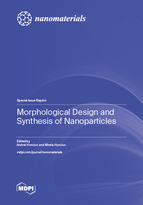Morphological Design and Synthesis of Nanoparticles
A special issue of Nanomaterials (ISSN 2079-4991). This special issue belongs to the section "Synthesis, Interfaces and Nanostructures".
Deadline for manuscript submissions: closed (30 September 2023) | Viewed by 29878
Special Issue Editors
Interests: design and synthesis of high-performance surfactants, electroactive amphiphiles and Janus nanoparticles; development of functional materials by polymerization of pickering emulsions and foams; surface and interfacial phenomena; development methods for measuring the surface energy of nanoparticles
Special Issues, Collections and Topics in MDPI journals
Interests: preparation and characterization of simple and multicomponent polymeric systems in the form of solutions/thin films/nanofibres/hydrogels, by different methods (spin-coating, solution casting, electrospinning, cryogelation, chemical crosslinking), based on synthetic/natural polymers and inorganic compounds (carbon nanotubes, clays, etc.); obtaining biomaterials with various external stimuli responses/delivery of active principles, for potential medical/pharmaceutical/cosmetic applications, or for various other applications in food, textile fields, etc.
Special Issues, Collections and Topics in MDPI journals
Special Issue Information
Dear Colleagues,
The latest trends in nanoparticle research are aimed at correlating the nanoparticle morphology and function. For example, the asymmetry of Janus nanoparticles endows these amphiphilic properties, and capability to partition at interfaces, self-assemble into suprastructures, emulsify or function as unidirectional nanomotors, etc. But there are numerous other examples of functionality that arises from the morphological design of the nanoparticles, for example in nanoparticle catalysis, in drug delivery systems, or nanoparticles used as technology enablers for designing nanostructured materials, interfaces and composites. The special issue Morphological Design and Synthesis of Nanoparticles is aimed at capturing a glimpse of the latest developments in the synthetic strategies of nanoparticles with unique morphologies that endows them with special functions, spanning a broad field of applications, from biology to catalysis, optoelectronics and beyond. This special issue is dedicated to promoting advances in synthetic strategies of nanoparticles with unique morphologies, design of materials derived from use of (multi-)functional nanoparticles, physicochemical investigations of phenomena arising from such nanoparticles, devices incorporating these nanoparticles as active ingredients, and new applications. We are looking forward to your contribution and hope that together we can unlock inspiring new perspectives and boost the interdisciplinary collaboration in this field.
Dr. Andrei Honciuc
Dr. Mirela Honciuc
Guest Editors
Manuscript Submission Information
Manuscripts should be submitted online at www.mdpi.com by registering and logging in to this website. Once you are registered, click here to go to the submission form. Manuscripts can be submitted until the deadline. All submissions that pass pre-check are peer-reviewed. Accepted papers will be published continuously in the journal (as soon as accepted) and will be listed together on the special issue website. Research articles, review articles as well as short communications are invited. For planned papers, a title and short abstract (about 100 words) can be sent to the Editorial Office for announcement on this website.
Submitted manuscripts should not have been published previously, nor be under consideration for publication elsewhere (except conference proceedings papers). All manuscripts are thoroughly refereed through a single-blind peer-review process. A guide for authors and other relevant information for submission of manuscripts is available on the Instructions for Authors page. Nanomaterials is an international peer-reviewed open access semimonthly journal published by MDPI.
Please visit the Instructions for Authors page before submitting a manuscript. The Article Processing Charge (APC) for publication in this open access journal is 2900 CHF (Swiss Francs). Submitted papers should be well formatted and use good English. Authors may use MDPI's English editing service prior to publication or during author revisions.
Keywords
- synthesis of nanoparticles
- multifunctional nanoparticles
- nanoparticle applications
- self-assembly of nanoparticles
- morphology and function in nanomaterials
- nanoparticles in optoelectronic devices
- nanoparticle catalysts
- nanomaterials for drug-delivery
- nanoparticles at interfaces
- nanoparticle-based composite materials
- nanoparticles at interfaces
- quantum dots
- nanomotors
- luminescent nanoparticles
- electrical properties of nanoparticles
- optical properties of nanoparticles







